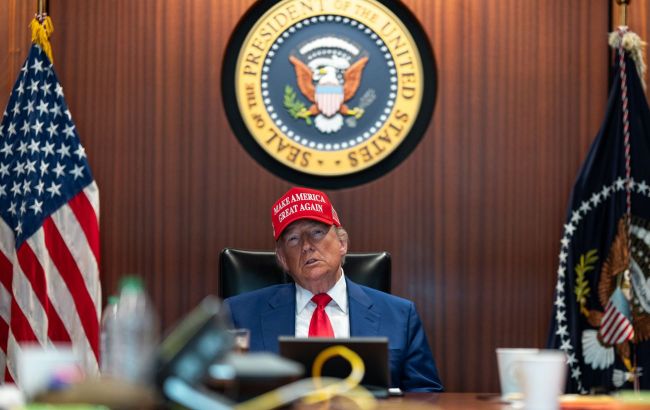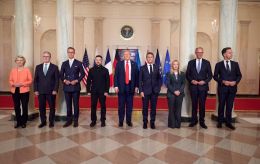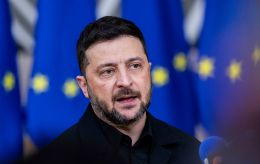Trump ended war? Details on resolution of Iran-Israel conflict
 Donald Trump (photo: Getty Images)
Donald Trump (photo: Getty Images)
Through the mediation of Donald Trump, Israel and Iran are gradually de-escalating their confrontation after 12 days of mutual attacks and are entering a ceasefire.
RBC-Ukraine explains what has contributed to the decline of the conflict and whether it has resolved the issue of Iran's nuclear program.
Key questions:
-
How did the exchanges of strikes between Israel and Iran end?
-
How is Trump trying to play the role of peacemaker between Jerusalem and Tehran?
-
Has the threat to Israel disappeared?
Did Trump reconcile everyone?
The latest round of escalation between Israel and Iran appears to be coming to an end. For more than 10 days, the Israeli Air Force attacked targets related to Iran’s nuclear and missile programs, as well as the enemy’s military leadership, but they were unable to destroy the entire nuclear infrastructure on their own. The United States stepped in, striking the most protected complex — Fordow — with specialized bunker-buster bombs.
In response to the attack, Iran launched a limited strike on US bases in Qatar and Iraq. However, there was no US retaliation. US President Donald Trump called Iran’s response "weak" and later stated that Israel and Iran had agreed to a complete ceasefire.
"On the assumption that everything works as it should, which it will, I would like to congratulate both Countries, Israel and Iran, on having the Stamina, Courage, and Intelligence to end what should be called, 'the 12 day war,'" added the US president.
This was later confirmed by other parties involved in the confrontation. Israeli Prime Minister Netanyahu stated that Jerusalem had accepted Trump’s proposal for a ceasefire with Iran and that all operational objectives had been achieved.
"Israel has removed a dual immediate existential threat – both in the nuclear and ballistic missile fields. Additionally, the IDF achieved full air control over Tehran’s skies, inflicted severe damage on the military leadership, and destroyed dozens of central Iranian government targets," said the Israeli government statement.
Meanwhile, messages from Iran have been contradictory. Tehran has not openly commented on Trump’s statements, but an unnamed Iranian official told Reuters that the country had agreed to a ceasefire.
According to CNN, the day before, US Vice President J.D. Vance, Secretary of State Marco Rubio, and Trump’s special envoy Steve Witkoff conducted negotiations with Iranian representatives — both directly and through indirect channels.
A senior Iranian official told CNN that Tehran had not received any official ceasefire proposals. The official also called the US and Israeli statements about the truce deception aimed at justifying further attacks, and said Iran "will continue fighting until a just solution is reached."
Morning incident
On the morning of June 24, Iran launched another, though limited, strike against Israel. It remains unclear why exactly Iran broke the ceasefire. Moreover, contradictory messages on the matter are being broadcast, said Serhii Danylov, deputy director of the Center for Middle Eastern Studies, to RBC-Ukraine.
"Was it an emotional reaction to Trump’s mocking that the Iranians got scared and warned about their attack on the American base? Or internal disagreements, because they did not have a clear version of the strike. The Iranians’ initial reaction was 'we didn’t launch anything, nothing happened.' Then state television commented — yes, we did launch, but it was in response to Israel’s violation of the ceasefire," Danylov told the outlet.
In response to the morning attack, Israel’s Ministry of Defense ordered the IDF to strike "regime targets," but Trump again intervened. Speaking to the media ahead of his trip to the NATO summit in The Hague, he expressed dissatisfaction with both Israel and Iran, emphasizing that he was especially disappointed with Israel’s actions. He also stated that Iran’s nuclear potential is "exhausted," and Tehran will not be able to revive its nuclear program.
Trump also promptly called Netanyahu, after which the ceasefire resumed. However, whether the current stage of the confrontation will end on this note remains an open question. Clearly, Trump will continue to act as a restraining factor, not only for Iran but also for Israel. Among other things, the US president said he did not want a regime change in Iran, as had been stated in Israel, because it could lead to "chaos." Still, a loss of control over the situation is possible.
Iran is defeated, but not completely
After the Israeli operation, Iran is facing increasing problems both on the international stage and within the country.
"Iran lost. In 12 days, it lost a significant part of its nuclear complex. And, no less — perhaps even more importantly — it lost military, political, and security capabilities. The regime has held on and maintained control. But now, after the operation ends, if it ends, it will face real challenges inside the country," Serhii Danylov told RBC-Ukraine.
The expert emphasized that now Iran will be nursing its wounds and rebuilding its resources. At the same time, asymmetric responses to Israel, such as terrorist attacks or strikes by Iranian proxy groups, could cause Tehran more trouble than benefit.
"A terrorist attack is effective only when the organizer goes unpunished. It is an asymmetric weapon. But when, after a terrorist attack, you can bomb the organizer’s headquarters — that is, the IRGC (Islamic Revolutionary Guard Corps) — the terrorist attack loses its operational advantage. So terrorist attacks may occur, but they will ultimately be counterproductive for the Iranians," Danylov concluded.
Meanwhile, Iran reportedly moved about 400 kilograms of uranium and other equipment from Fordow before the US strikes. This was reported by two Israeli official sources and Reuters, citing an Iranian source.
Satellite images from Maxar dated June 19–20 showed logistical activity, including 16 trucks and heavy equipment near the entrance to the site, which may indicate the movement of materials. It is currently unknown where the uranium and enrichment equipment were relocated. This creates additional risks for Israel and grounds for renewed conflict.
Sources: materials from Reuters, CNN, Axios, Times of Israel, statements by Donald Trump, and comments from Serhii Danylov.

